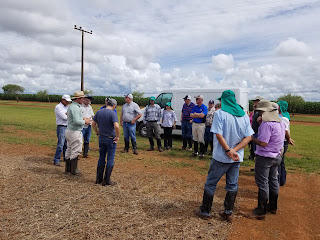
Our first stop on this day was to visit one of the soybean growing champions of Brazil. We traveled about 5 miles off the main road to the farmstead of the family. They had prepared a nice breakfast of treats and drinks for us. They described their farming operation and then went over the details of the soybean contest field that yielded 136 bushels/acre. Some of his secrets to success were building soil fertility over a long period, minimizing compaction, superior varieties and using a special inoculant. We had the opportunity to ask many questions and then headed to the field to examine some of his variety plots and the new contest area. The growing season has been wet and the soybeans were tall and lodging with a fair amount of white mold. We also noticed that the lower nodes on the bottom 10 inches had few pods. They attributed this to wet weather after emergence.
From there we headed to lunch in Guarapuava. This town was mostly a German immigrant city that was started with the immigration of 500 German families in 1951. After lunch we visited the Agraria Coop. This is a modern and innovative coop that has 600 members. It has a corn mill, malt facility, soy crushing plant, feed mill, seed production facility, dairy and hog slaughtering facility. In addition they have a private research foundation called FAPA that supports growers with applied research and advisory services. The cooperative is able to coordinate the entire production process from planting to harvest to processing to marketing the end products. A quality control lab ensures that products are high quality. This is much different from Pennsylvania where these are disconnected.
From the Coop we visited the FAPA research center where they were preparing for a large field day. We had some indepth discussions of disease and weed management with their scientists. There is a real need here to use IPM to manage weeds and diseases.
After the meeting we headed to the hotel and then to a German restaurant/microbrewer where we had a short tour of the brewery and a traditional German meal.
y
 We reviewed the
critical need for IPM, importance of roots and straw in no-till Brazilian soybean production. We also learned about inoculant use here and
some of the new combinations that they are working with.
We reviewed the
critical need for IPM, importance of roots and straw in no-till Brazilian soybean production. We also learned about inoculant use here and
some of the new combinations that they are working with.















